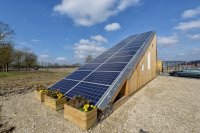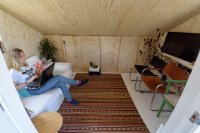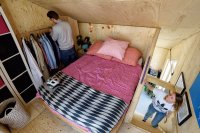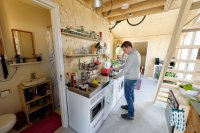Photos: Guy Ackermans
The wooden house with solar panels on the roof is an eye-catcher. It stands on an open patch of ground on the outskirts of Wageningen, on the corner of the Marijkeweg and the Haarweg, where the WUR building Zodiac used to be, with a few greenhouses behind it. Before long, construction will start here on Tuinwijk, the second half of the Nieuw Kortenoord neighbourhood.

There is no doorbell. We’ll just have to do it the old-fashioned way: walk around the back and knock on the window. There is a red sign in the windowsill saying: SolarCabin, a home away from home. This is a reference to the cabin’s history, explains Master’s student Robin Rosendahl as soon as he has opened the door. The SolarCabin is one of six winning designs in a competition set up by the Dutch asylum seekers’ organization COA. Robin lives here with his girlfriend Amanda Krijgsman. ‘No, we don’t have a bell. Nor an official address. But we don’t get very much post anyway.’
Panoramic view
These are minor omissions in a house that is otherwise too good to be true. Just imagine. Your first rented accommodation a detached house on the edge of a town. Brand new, and for 100 euros a month each. A southwest-facing garden and a panoramic view. And to give you that green feeling, 26 solar panels on your roof. ‘We can’t believe our luck,’ comments Amanda. And it didn’t take much effort from them. Last year, student housing provider Idealis advertised for candidates for the SolarCabin. ‘There weren’t many requirements. Yes, to share our positive experiences of living here,’ explains Robin. ‘And once a quarter we have to give a guided tour for people who are interested.’

The solar house is compact. Tiny, in fact. But it has all the usual spaces. The open kitchen even makes a spacious impression because of the high, sloping ceiling. Where two racing bikes are suspended. There isn’t much storage space so every little corner gets used. Behind the kitchen is a small living room. Or bedroom, depending how you use it. And a broad staircase leads from the kitchen to an upstairs bedroom, with a view over the building site. Robin and Amanda have about 31 square metres at their disposal: more than twice the size of the student room they used to live in on the Dijkstraat. ‘To me it all seems quite spacious,’ says Amanda.
Asylum seekers
The SolarCabin is a unique residence. Literally. It is the only one of its kind. Robin and Amanda are living in the prototype which architect Arjan de Nooijer of dNArchitecture designed for the COA competition. The challenge was to come up with “an innovative and flexible housing solution’ for asylum seekers. The six winning design were in pride of place at the Dutch Design Week in Eindhoven last autumn.

And there the way was paved for the solar house to be moved to Wageningen, says project director Tjakko Smit of Bouwfonds Property Development, which is building the sustainable neighbourhood Nieuw Kortenoord. ‘We have offered to have the house here for a year. With people living in it, so as to test whether it really is habitable.’
Although the concept was developed for asylum seekers before or after they gain resident status, it is an attractive option for students such as Robin and Amanda too. OK, it is a little cramped at times – you can hardly turn around in the toilet and shower. Robin: ‘And the upstairs is open, so all the hot air goes straight up there. It can take time to warm up downstairs.’ But looking on the bright side, all the electricity comes from your own roof. The 26 solar panels produce more electricity than the two students consume, which makes the SolarCabin a tiny power station and means the concept covers some of its own costs. A metre in the kitchen keeps track of precisely how much electricity is generated.

Staring
The interior is plain undecorated wood. Amanda and Robin are allowed to decorate it, though. Amanda: ‘We got carte blanche from the architect to turn it into our own home. We are allowed to drill holes and hang things up, and to paint the walls if we want. We made the cupboards ourselves. It’s so nice to furnish your own place.’
The house has been attracting a lot of attention, especially at weekends when people go out walking. Robin: ‘Passers-by often stare in through the windows. Until they see us sitting there, and then they get a shock.’
